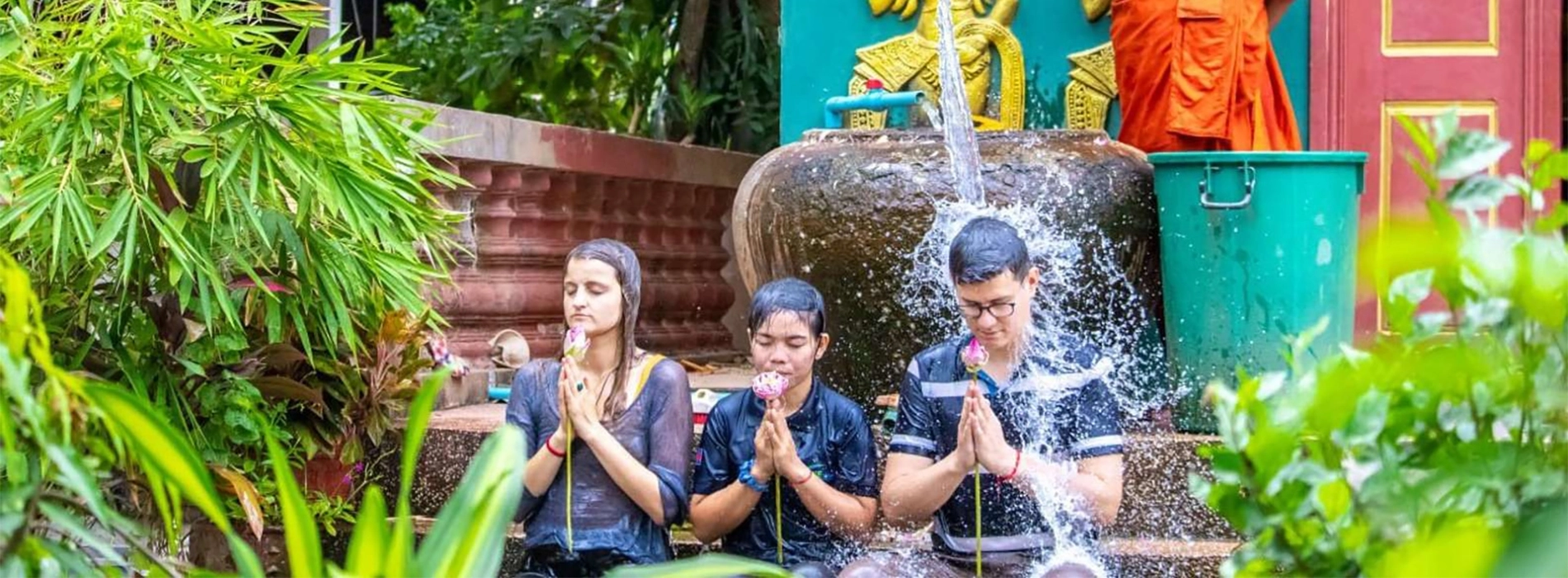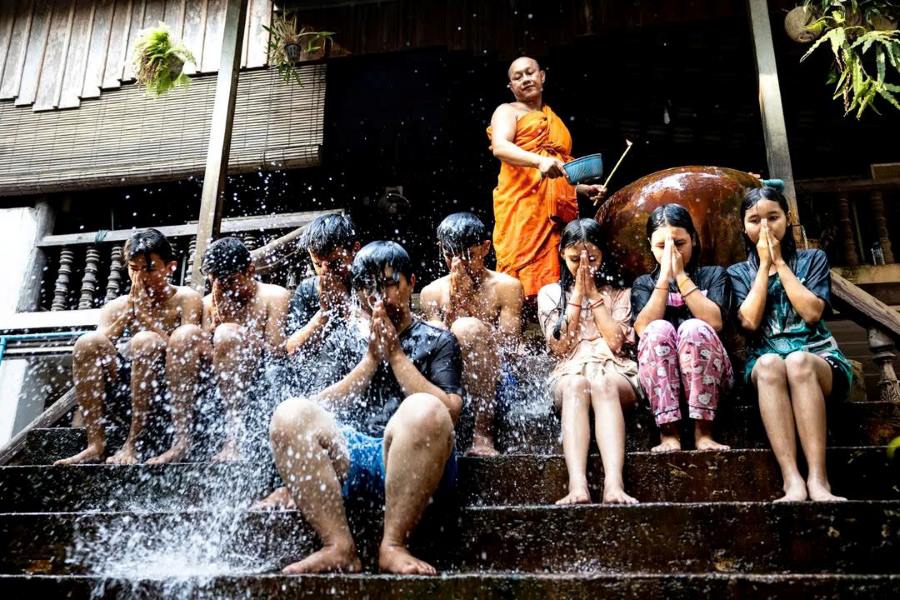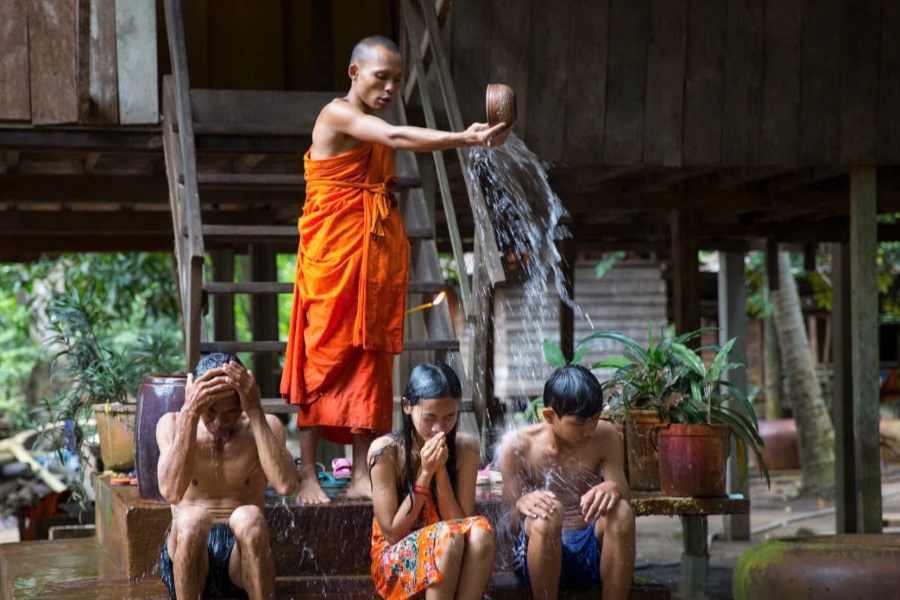
In Cambodia, the Water Blessing Ceremony continues to be widely practiced and celebrated and opens its doors to foreigners who are eager to experience Cambodian culture. The blog will help you know more about this traditional ceremony which remains faithful to its historical roots.

Understand the meaning and the spiritual practices of this unique ceremony (Source: Angkor Travel Photography)
In simple terms, a Water Blessing Ceremony is when monks chant and sprinkle, or pour blessed water over people to give them good luck, happiness, and health. This is most frequently done in sacred precincts such as pagodas or temples, which adds weight to its spiritual meaning.

The traditional Water Blessing Ceremony in Cambodia (Source: Essence of Indochina)
The Water Blessing Ceremony symbolizes the cultivation of calmness, clarity, and purity of body, speech, and mind. The purpose is to cleanse oneself of constraints and generate compassion and wisdom. The ceremony can also meant to end misfortune and bad luck or to ask for good luck in the future.
.jpg)
In Buddhism, water is a symbol of purity, clarity, and renewal (Source: Shinata Raya Residence)
The practice of the Water Blessing Ceremony itself can be found within ancient Cambodian customs. People believe that the ceremony has been closely related to both Hindu and Buddhist traditions.
After Buddhism became the predominant religion in Cambodia, the Water Blessing Ceremony had more richness of cultural experience. It provided a link between the ceremony with religious significance and the Cambodian cultural identity.

The Buddhist Water Blessing Ceremony stems from Hindu practices (Source: trekkingbarris)
Throughout Cambodian history, the Water Blessing Ceremony has persisted as an important tradition, often held at sacred sites such as ancient pagodas and temples.
The ritual can be done for various occasions, such as weddings, birthdays, special ceremonies, house moving, before traveling, or even important communal gatherings. Locals will head to their neighborhood temple or invite a monk to their home to perform the ceremony.
1. The Sprinkling Water Blessing Ceremony
The monks chant harmoniously and sprinkle blessed water over the participants as a way to experience the culture and faith of the Cambodians. This ceremony type normally takes about one or one hour and a half to get it all done and it ends with a wishing red tie.
.jpg)
The Sprinkling Water Blessing Ceremony is popular with locals and tourists (Source: Klook)
2. The Heavy Water Blessing Ceremony
Try to form a deeper spiritual connection with the second blessing which is a longer ceremony that involves the monks pouring vessels of blessed water over your head. This traditional blessing ceremony takes approximately two hours and a half to three hours including visiting the pagoda, and it is fully accomplished by a wishing red tie by monks.
This ceremony type involves more detailed rituals, extended chanting, and blessings. The monk usually spends more time performing prayers and preparations before pouring the water, and the process of dousing itself takes longer.
To ensure your comfort, you will be provided with a sarong to change into so that your clothing remains dry.
.jpg)
Experience the Heavy Water Blessing Ceremony (Source: No Guidebooks)
Read more: Water Splashing Festival in Cambodia
Before the ceremony
Before getting ready for the traditional ceremony, you will have the unique opportunity to talk to a monk at the pagoda. during the conversation, you will hear about his personal stories, and learn more about Buddhist beliefs, the role and structure of a local temple, and activities at the temple.
.jpg)
Take the chance to learn more about the religious culture of the Cambodians (Source: Your Tour Desk)
This is your moment to ask any questions related to Buddhism and Cambodian traditional beliefs. After the monk has shared some wisdom, you will present the monk with incense sticks and candles.
During the ceremony
First, instructions will be given about preparing the flowers to offer to the monks as a gesture of respect and devotion. After that, chanting and meditation follow with the monks leading, infusing the place with peace and introspection. The chanting helps to create an atmosphere of purity of mind and positive energy.
After that, some prayers and mantras by the monks follow in the blessing of the water. The blessed water is finally either sprinkled or poured over the hands or heads of the people present.
Then a bright crimson symbolic bracelet is given to you as a gift of a peaceful life and blessed to keep following the monk's blessing. The monks make it by hand twisting orange and red threads so now two colors are present, forming a ring around your arm. The colors represent the sun at its best - sunrise and sunset.
.jpg)
The bracelet is a reminder always to be your best (Source: Get Your Guide)
Ultimately, you can offer prayers for anything you can think of like good fortune, safe travel, and a long and happy life.
After the ceremony
After the blessing, you can enjoy local fruits and drinks, discover the temple grounds, take photos, as well as have a view in silence adoring the art of Khmer architecture, and religious artifacts. Some might choose to take time for meditation while reminiscing about the unique and memorable moment of the ceremony.
.jpg)
Temples in Cambodia often have prayer halls and tranquil gardens (Source: Phnom Penh Post)
There are various Buddha pagodas and ancient temples in Cambodia perform the Water Blessing Ceremony. Here are some recommended spots where you can feel the spiritual atmosphere most.
1. Angkor Wat Complex
Angkor Wat, a religious center of Cambodia, is home to many monks. You can wander around the extensive temple compound and then visit smaller temples where resident monks carry out water-blessing ceremonies. The most common places are Wat Preah Prom Rath or Wat Damnak.
.jpg)
Angkor Wat Complex (Source: Hello Angkor)
2. Wat Po Banteay Chey
Wat Po Banteay Chey is located south of Siem Reap. This temple is well-known for its welcoming environment and knowledgeable monks who conduct meaningful Water Blessing Ceremony. The temple offers a serene atmosphere where you can deeply immerse yourself in this Cambodian spiritual tradition.
.jpg)
Wat Po Banteay Chey (Source: Arrankeen’s Site)
3. Wat Phnom
Wat Phnom is a hilltop temple that is central to the capital - Phnom Penh and another significant location where you can receive a water blessing. This temple is not only a spiritual center but also a symbol of the city's origin. Participating in a water blessing here, amidst the bustling city, offers a moment of peace and spiritual connection.
.jpg)
Wat Phnom (Source: Wikipedia)
4. Wat Botum
Known as one of the oldest temples in Phnom Penh, Wat Botum is a beautiful and tranquil place. It’s less crowded compared to others, making it a perfect spot for a more intimate and personal water blessing ceremony. The monks here are welcoming, and the serene environment enhances the spiritual experience.
Wat Botum (Source: Wikipedia)
5. Wat Leu
For those who visit the coastal regions of Sihanoukville, Wat Leu offers a unique setting for the Water Blessing Ceremony. Lied on a hill with beautiful views of the surrounding area, this temple provides a tranquil escape from the busy coastal towns. The monks at Wat Leu perform the water blessing with the backdrop of serene landscapes, making the experience even more memorable.
.jpg)
Wat Leu (Source: Trip Hunter)
.jpg)
Remember the tips for a better experience (Source: Besty Herbert)
The Water Blessing Ceremony serves as a powerful reminder of the importance of community and cultural identity within Cambodian society. The enduring nature of this ceremony highlights its significance in fostering hope and luck among participants, reflecting the resilience of Cambodian traditions over time.
Make sure to reach us if you want to personally experience this sacred ceremony and get the chance to connect with the culture and beliefs of the local people.
Read more: Explore Bom Chaul Chnam Festival in Cambodia